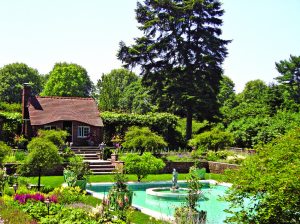
Experience the fascinating underworld of Prohibition on the North Shore heritage trail
By Long Island Path Through History Researchers
Prohibition-era bootleggers, desperate for a clandestine way to transport their moonshine whiskey and bathtub gin, found just what they were looking for on Long Island’s Vanderbilt Motor Parkway, the first roadway designed exclusively for automobiles. Privately owned and free from police jurisdiction, Vanderbilt Parkway offered the perfect conduit for so-called rumrunners to ferry their illicit libations from New York City to Long Island. Though Prohibition finally ended in 1933—and Vanderbilt Parkway closed in 1938—memories of that beguiling era still linger in the form of the North Shore Heritage Trail (www.longislandheritagetrail.com). Primarily following Route 25A, the Heritage Trail is a self-driven tour that offers a beautiful, accessible way to explore Long Island’s past and present. Step back in time and follow one of three drives to Great Neck, Sands Point and Port Washington; Glen Cove, Roslyn and Old Westbury or Oyster Bay.

Great Neck, Sands Point and Port Washington
It was an altogether typical Friday night at The Isaac Guggenheim Estate in April of 1924: New York’s elite gathered for an extravagant celebration and sipped their forbidden drinks under cover of darkness. Before night turned to morning, however, federal agents raided the estate and seized more than 800 cases of liquor, brought in by rumrunners via Hempstead Harbor and hidden throughout the woods. The quality and quantity of the confiscated alcohol was so great that it was proudly displayed in front of police headquarters as a bizarre trophy.
Today, history-seekers can tour Sands Point Preserve (95 Middle Neck Road, Sands Point; 516-571-7900) and visit the Falaise, one of the only remaining early 1900s castles on The Guggenheim Estate and former home of Harry F. Guggenheim. The Falaise—a Norman-architecture, Gold Coast Period mansion—was where Charles Lindberg and his wife, Anne, first heard about the kidnapping of their son. Tourists at Sands Point Preserve are afforded the rare opportunity to experience the grandeur of the Roaring 20s through the mansion’s full display of its original furnishings, antiques, sculptures and paintings.
After visiting the Preserve, head over to Great Neck and take a stroll down the tree-lined sidewalks of the downtown shopping district. With more than 250 shops and restaurants, there’s something for everyone.

Glen Cove, Roslyn and Old Westbury
In 1930, flush with cash and an unrequited taste for sparkling wine, Standard Oil boss Herbert Lee Pratt ordered 240 cases of French champagne shipped in flowerpots from Marseilles to his opulent Glen Cove estate, The Braes. Soon after, The Braes was raided by U.S. prohibition agents. Pratt’s lawyers quickly went on the defensive: “Mr. Pratt did just what you or I or anyone with money enough to do so and a desire to buy liquor would have done.”
The Braes Estate still stands in Glen Cove, where it serves as the campus for the Webb Institute. While in Glen Cove, take in the scenic downtown area and visit the many shops and restaurants. Then head over next to the historic village of Roslyn and enjoy the harbor views.
If English splendor is what you’re seeking, motor over to Old Westbury Gardens (71 Old Westbury Road; 516-333-0048), the former estate of John Shaffer Phipps, heir to the U.S. Steel fortune. Featuring 23 lavish rooms, sweeping lawns and intricate English gardens, visitors will be transported to the age of opulence and lost innocence.

Oyster Bay
To William Robert Coe and his wife, Standard Oil heiress, Mai Rogers Coe, one room of the 65 in their new estate was clearly more important the rest: the den. For the den, and its accompanying bar, was included in the mansion’s original 1918 blueprint and thus free from the laws of prohibition that wouldn’t be set for another two years. Visitors to the Coe Mansion (1395 Planting Fields Road; 516-922-9200) can tour this beautiful, handcrafted bar and contemplate the inconsistencies of the Prohibition, when a bar such as William Coe’s could exist in the gray area between legal and illegal.
Tours of Coe Mansion are offered at 12:30 and 2:30 p.m. daily. After visiting the mansion, be sure to stroll through Planting Fields Arboretum’s gardens, greenhouses and rolling lawns.


While in Oyster Bay, make time for Sagamore Hill (20 Sagamore Hill Road; 516-922-4271), home of President Theodore Roosevelt from 1858 until his death in 1919. A tour of the Sagamore Hill grounds offers an unparalleled experience for history buffs; the home has remained virtually unchanged for longer than a century. Visitors can see more than 20 rooms of the house, as well as 83 acres of forested areas, meadows and salt marshes providing home to birds, small mammals, turtles, frogs and insects. Experience firsthand why Roosevelt once said, “At Sagamore Hill, we love a great many things—birds and trees and books—and all things beautiful—horses and rifles and children and hard work and the joy of life.” Sagamore Hill operates tours of the Roosevelt Home seven days a week from Memorial Day through Labor Day.
































